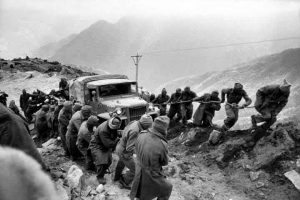20 October 1962
Sino-Indian war started.
What happened?

On 20 October 1962, the Sino-Indian war started with simultaneous Chinese offensives in Ladakh and along the McMahon Line. The war ended with a Chinese ceasefire a month later and a defeat for India.
Sino-Indian War (1962 War with China)
- The Himalayan border dispute was the chief pretext of the war. China claimed the Aksai Chin area in Ladakh, Kashmir and the Tawang area in Arunachal Pradesh as its own (Aksai Chin as part of its Xingjiang and Tawang as part of Tibet).
- The Aksai Chin is a desert of salt flats that is about 5000 m above sea level. The eastern front where the war took place, i.e., Arunachal Pradesh is a mountainous region having many peaks above 7000 m over sea level. So, the war was fought under extreme harsh conditions of terrain and freezing climate. Many soldiers died due to these conditions as well.
- After independence, India maintained a cordial relationship with its northern neighbour which is also a country with which India has had historical and cultural ties for centuries.
- In 1954, the Panchsheel or the Five Principles of Peaceful Coexistence was signed between India and China. India even supported China in international representation. However, things took a turn for the worse when China announced its occupation of Tibet. India proposed negotiations on the Tibet issue. After the 1959 Tibet uprising, India had given asylum to the Dalai Lama and this obviously did not go down well with the Chinese. China perceived India as a threat to its rule over Tibet and this was also a major reason for the war. Mao Zedong even went on to state that the uprising in Lhasa, Tibet was caused by Indians.
- In 1960, the Chinese premier Zhou Enlai suggested that if India gave up its claim over Aksai Chin, China would drop its claim in Arunachal Pradesh (then called the North Eastern Frontier Agency). But Nehru rejected this outright saying China had no legitimate claims over both the areas.
- Throughout the summer of 1962, there were skirmishes along with the border areas between troops of both countries.
- India started following a ‘Forward Policy’ where it began to send troops and patrols to disputed border areas. Some of these troops even went beyond the Indian borders. This move deteriorated relations between both nations.
- Also, the Indian leadership did not believe that China would attack. The army was also ill-prepared for any major war. Indian soldiers were heavily outnumbered by Chinese troops. Indian planning was shoddy before it sent troops to the disputed areas.
- In the fighting that went on for a month on both the western and eastern fronts, nearly 3000 Indian soldiers were killed and about 1000 more injured. India had asked for help from the superpowers USA and USSR but did not get any help.
- Both China and India did not use their navy or air force in the war.
- China declared a ceasefire on 21 November since it reached its claim lines, and also stated that from December 1, 1962, the Chinese frontier guards would retreat 20 km behind the Line of Actual Control.
- After the war, India increased its support for Tibetan refugees and revolutionaries.
- The defeat in the war also led to the resignation of the then Defense Minister V K Krishna Menon, who was blamed for the lack of preparedness of the army.
- Another consequence of the debacle was that India modernized its armed forces and became more prepared in later conflicts. It also perhaps taught the political leaders to be extra cautious and vigilant when it comes to matters of national security.
Also on this day
1991: Earthquake in Uttarkashi killing over 1000 people. 2011: Libyan ex-leader Muammar Gaddafi killed.
See previous ‘This Day in History’ here.
Also, see:
| Bangladesh Liberation War |
| Pakistan surrendered to Indian forces in the Indo-Pakistan war 1971 |
| Second Indo-Pak war begins |

Comments